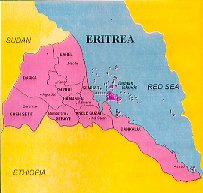


INTRODUCTION :
Modern industry was introduced in Eritrea by the Italians in the last quarter of the 19th century. In the 1940s small scale manufacturing enterprises mushroomed in Eritrea due, among others, to the adverse economic situation in Europe. during that period, a variety of Eritrean industrial products used to be exported to the Cyprus, Djibouti, Egypt, Ethiopia, Iran, Sudan, Yemen and other neighbouring countries.
Unfortunately thirty years of armed struggle and deliberate policies of neglect and mismanagement by the last two regimes in the country had made growth of manufacturing activity practically impossible. the declaration of Eritrea's independence marks a yarning point for the reconstruction of the manufacturing sector.
At present there are about 1,000 manufacturing enterprises in Eritrea. Most of the 730 enterprises which were in existence as on May 24, 1991 were more than 20 years old (the oldest going back 10 1901). About 300 have been established after liberation.
Manufacturing units which were established and run by the Eritrean People's Liberation Front during the liberation war for the production of plastic shoes, sanitary towel, baby food, bandage, macaroni, plastic household utensils, knitwear and engineering workshop products have been merged to related state enterprises.
Export for 45 state enterprises, all the rest are privately owned. Most of them are owner operated and single proprietorship serving customers in their immediately locality. Currently, the sector which is in need of modernisation and rehabilitation is very much dependent on imported raw materials, spare parts, machinery and know-how.
The major current manufactures of the country are composed of
The manufacturing enterprises of the country are currently concentrated in the major urban centres and more particularly in the capital city, Asmara. In line with the balanced regional development policy of the Government, new industrial establishments are thus being encouraged to be set up as much as possible Asmara.
Given the market oriented economic policy of the government and
its commitment to privatise the currently state enterprises and
the conducive investment climate and ideal location of Eritrea,
the industrial sector is foreseen to play a dynamic role in speeding
up the development of the economy. Eritrea's dedicated and disciplined
work force in combination with local and diaspore capital coupled
with foreign capital and know-how are foreseen to usher in a modern
and flourishing industrial sector in the country within the not
too distant future.


Chamber premises
1. MILESTONES
ASMARA CHAMBER OF COMMERCE
- In its embryonic state the Chamber came to be known as the Association of Exporters and Producers of Eritrea (A.E.P.E.) which undertook the normal activities of a chamber and published a fortnightly journal entitled: "The Bulletin of Commerce, Industry, Finance and Agriculture of Eritrea."
- The Chamber of Commerce made its debut in a small rented house and later on moved to a modest building acquired from the government on a nominal rental.
- The constitution or Memorandum of Association of the Chamber was confirmed on 20.7.1953 under Registration No. 34235 - 22883.
2. CURRENT SETTING
2.1 ORGANISATION
The principal organs of the Chamber are the :
The Secretariat of the Chamber at present consists of 25 employees, organised under the Secretary General's office and its three departments, ie.
2.2 MEMBERSHIP
The Membership of the Chamber which was below 500 until 1978 reached a peak of about 7200 by 1989 as a result of the replacement of its voluntary membership with mandatory membership pursuant to the promulgation of Proclamation 148 of 1978.
3. CHALLENGES AHEAD
It is regrettable to note that the Asmara Chamber of Commerce despite its praise worthy achievements during the first three decades of its life and particularly during the second and first half of the sixties and seventies respectively, was turned starting 1978, into a camouflage institution totally under the control of and subservient to the whims and dictates of the defunct Derg regime.
Now, however, the dark days of the Derg are gone. A bright atmosphere of national consciousness and positive spirit of preparedness to rehabilitate and reconstruct the battered Eritrean Economy and to lay a sound and strong base for its further speedy economic development has set in. The initial steps so far taken and under way are also quite promising.
It is gratifying to note, with great appreciation, at this juncture, that the Government has already taken a just and opportune step in restoring to the Chamber its own very building from which it was unfairly evicted in 1982 by the Derg regime. Furthermore the Government, with the close involvement of the Chamber, is working on a new Proclamation regarding the constitution and role of Chambers of Commerce in new Eritrea.
In the light of the above developments the challenges ahead with respect to the re-organising of the Chamber and rendering it an effective instrument or body representing the interests of the business community and a center of concerted efforts for the economic reconstruction and development of Eritrea cannot thus be seen lightly. ?It is needless to underscore that they call, first and foremost, for the spirited involvement of its Membership and the strengthening of its Secretariat.
Accordingly appropriate steps would be required to be taken on
time based on a realistic plan of action. It is important to
note that the domestic efforts to be exerted would need to be
re-inforced by external technical expertise and material assistance.

 go back
go back